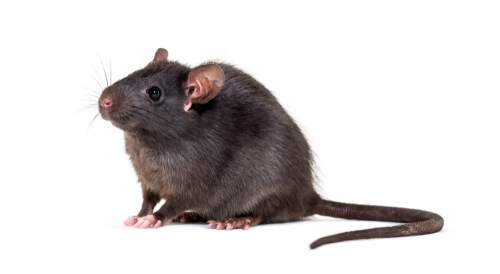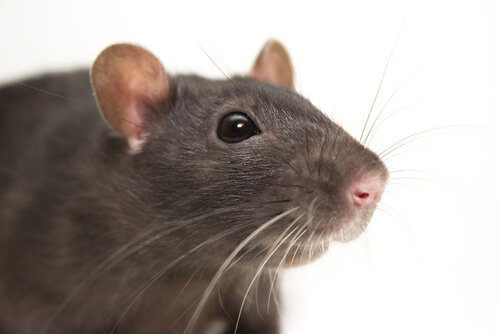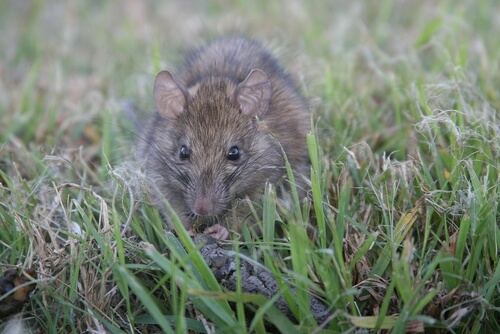
| Kingdom | Animalia |
| Phylum | Chordata |
| Class | Mammalia |
| Order | Rodentia |
| Family | Muridae |
| Genus | Rattus |
| Species | Rattus rattus |
| Niche | Generalist Omnivore |
| Length | 5.0-7.2 in (12.7-18.3 cm) |
| Weight | 2.6-8.1 oz (75-230 g) |
| Lifespan | 12-18 months |
| Social Structure | Social |
| Conservation Status | Common, Invasive |
| Preferred Habitat | Tropical forests |
| Average Litter Size | 7-8 |
| Main Food Items and Prey Species | Seeds, nuts, leaves, insects, etc. |
| Predators | Owls, cats, weasels, |
The Basics
The black rat (Rattus rattus) is a species of small, long-tailed rodents. It appears like a stereotypical rat and is found worldwide. It is often also referred to as the ship rat, roof rat, or house rat and is known as a pest to farmers but is also kept as a pet by some.
Black rats are 5.0-7.2 in (12.7-18.3 cm) long, excluding their tails which is about the same length if not longer. Most specimens weigh 2.6-8.1 oz (75-230 g) and are a dark brown or black color, although several lighter color morphs exist. Its fur is scruffy and their underside is typically a lighter color than the rest of their bodies.

The origins of the black rat are unclear. It likely traces back to Malaysia with speciation occurring when it arrived in India. Once it reached Europe, it was carried throughout the world during the colonial era. Currently, its distribution is cosmopolitan and it can be found in both natural habitats and human-developed areas around the world, particularly in warmer climates. It is not as widespread as its larger cousin, the brown rat (Rattus norvegicus), which has also been more successful in areas developed by humans due to its burrowing tendencies. The black rat is arboreal and tends to live in trees. Therefore, it was more successful in adapting to human-developed areas when thatched roofs and wood buildings were more common than they are today, having been replaced by concrete and brick construction methods in much of the world.
Diet and Predators
Black rats are omnivores and eat a variety of foods. In fact, they will eat almost anything. Typically they will subsist on parts of plants such as the stems and leaves as well as seeds and fruit. They will also eat fungi and a wide variety of small animals such as insects and other items such as bird eggs. In human-developed areas, they may eat from food left out for domestic pets as well as garbage and other food waste, pointing further to the generalist strategy that has allowed them to become common in so many places around the world. They will also feed on crops such as wheat, sugar cane, coffee, cocoa, and more, making them well-known pests to many farmers.
Being so widespread, the black rat is prey for many other species. In natural settings, weasels and other larger rodents will frequently attack rats and their young. Wild cats, foxes, coyotes, and more will also prey on the black rat. In human-developed areas, they will often be killed by cats as well as owls that make use of the large clearing to spot its prey. However, the black rat is agile and a very competent climber. It also has an excellent sense of hearing. Combined, these make it highly capable of avoiding predation in most scenarios, which is why it has managed to colonize so much of the world despite these novel predators in some habitats black rats arrived to.
Breeding
Black rats form dens within trees and, at times, underground. During the breeding season, male black rats will increase the size of their home ranges in search of mates. The gestation period for females is only 21 days and the young are independent within weeks. Most rats reach sexual maturity within 3-5 months and generally only live for 12-18 months in the wild. During this time, females will give birth to about six litters of about 7-8 young. With such a short life-cycle and highly productive breeding habits, it is easy to see how the black rat has been so successful in colonizing so many environments globally.

Fun Facts about Black Rat!
Black rats are widespread and ubiquitous. They have been associated with some of the worst outbreaks of human disease in history, but in some cases are actually helping to improve biodiversity in previously disturbed habitats throughout the world.
The Green Rat
Not all black rats are black. Many are brown, but should not be confused with the brown rat, which itself is a separate species with different characteristics and habits. Some black rats have white fur. Perhaps even more strangely, selective breeding efforts that occurred in England in the 1920s led to the development of various color morphs, including a green variety.
The Passive Traveler
The black rat, along with other rat and rodent species, is one of the most widespread species on the planet. Rats are known to have made their way around the world largely by hitching a ride on ships that they lived in. Many animals and organisms have fascinating dispersal methods such as plants that use the wind to spread their seeds far. Despite being much more intelligent and cognizant that plants, rats made their way around the world almost equally as passively. Since these fortuitous first journeys, rats have become present in natural and human-developed habitats throughout the world and, in many cases, have become pests and are a threat to native species.
The Great Invader
While the black rat’s ability to move throughout the world may seem like a success story, this is not always true when considered from the perspective of other species in the habitats to which it arrived. For example, in the north of New Zealand, these rats feed on the seedlings of various plants. This can greatly disrupt forest succession and significantly impacted these ecosystems. In many cases, their generalist feeding strategy allows them to outcompete various native species for resources resulting in a significant decline in these populations.
In some cases, however, the arrival of the black rat has had arguably beneficial impacts. For example, where native species have been extirpated due to human disturbance, black rats have often thrived. In Australia, for example, they have become the vectors for the spores of some fungi on which they feed. This role had previously been filled by native species. Without this passive dispersal, biodiversity would be negatively impacted. Ironically, this means that eradicating the pest may do more harm than good in some instances.
A Vector of Disease
While they travel the world, rats also bring other organisms with them, including harmful viral and bacterial infections. This is particularly due to its ability to contain a high amount of infectious bacteria in its blood.
Sometimes, these may even be inside of other organisms living on the rats, such as fleas. Indeed, the black rat is likely responsible for spreading a flea-borne bacteria known as Yersinia pestis, which is responsible for the Black Death and the Plague of Justinian.
